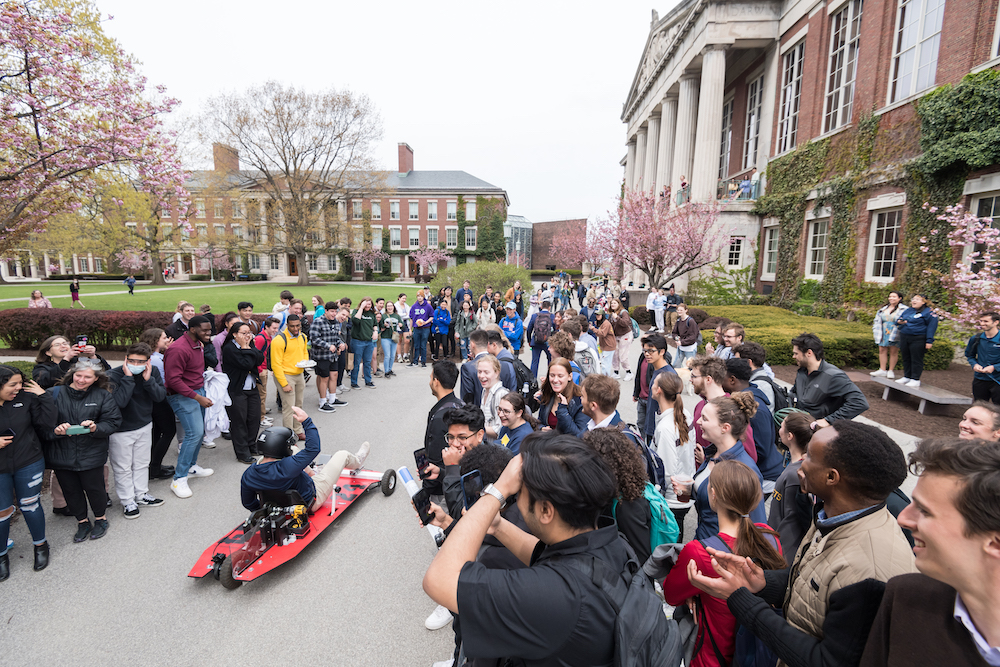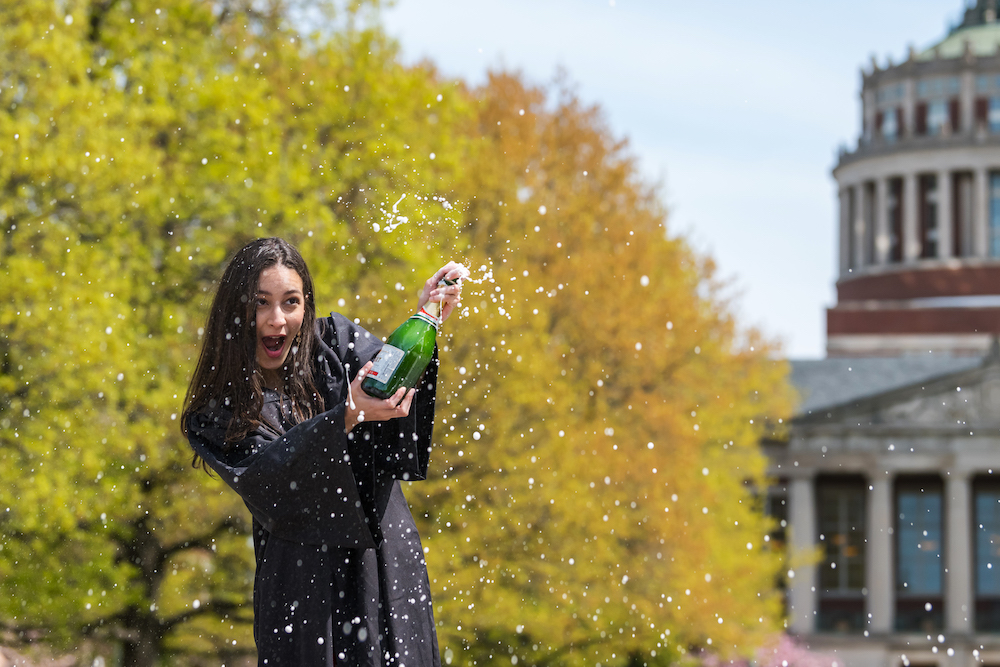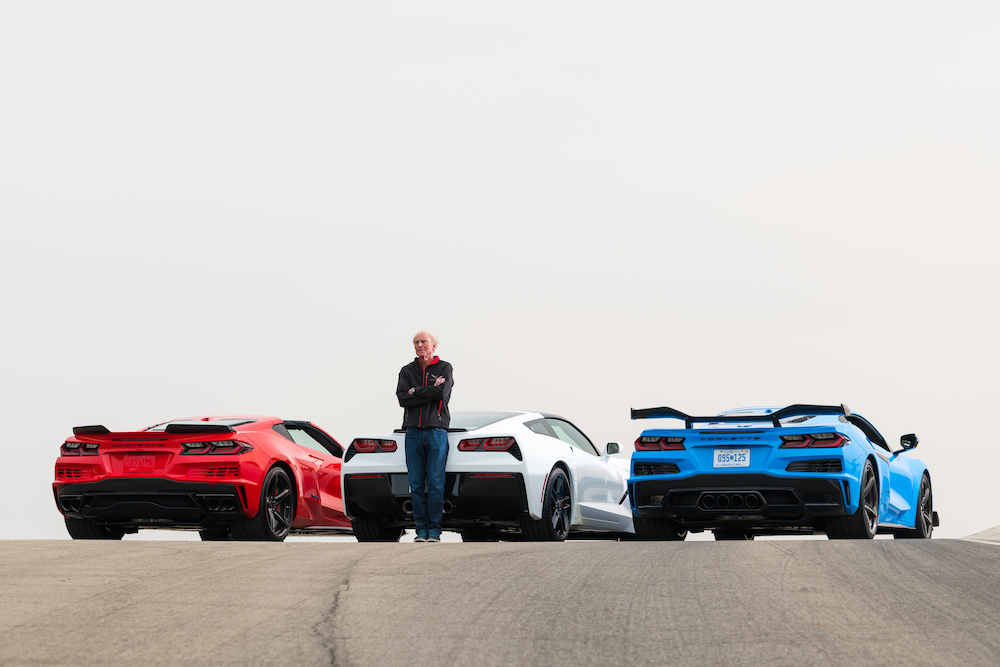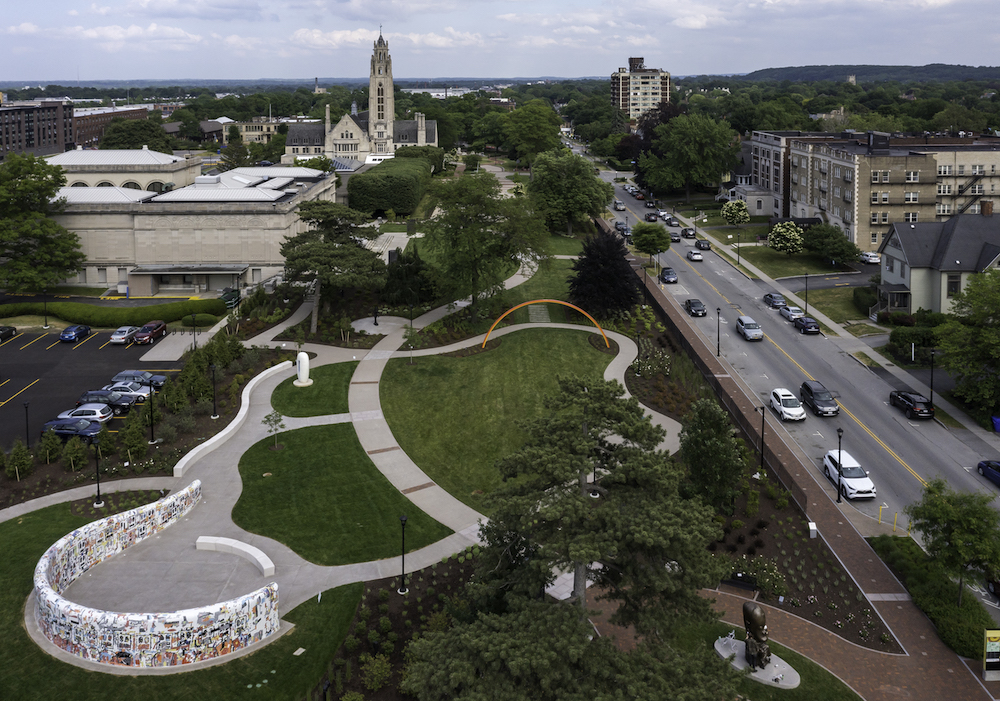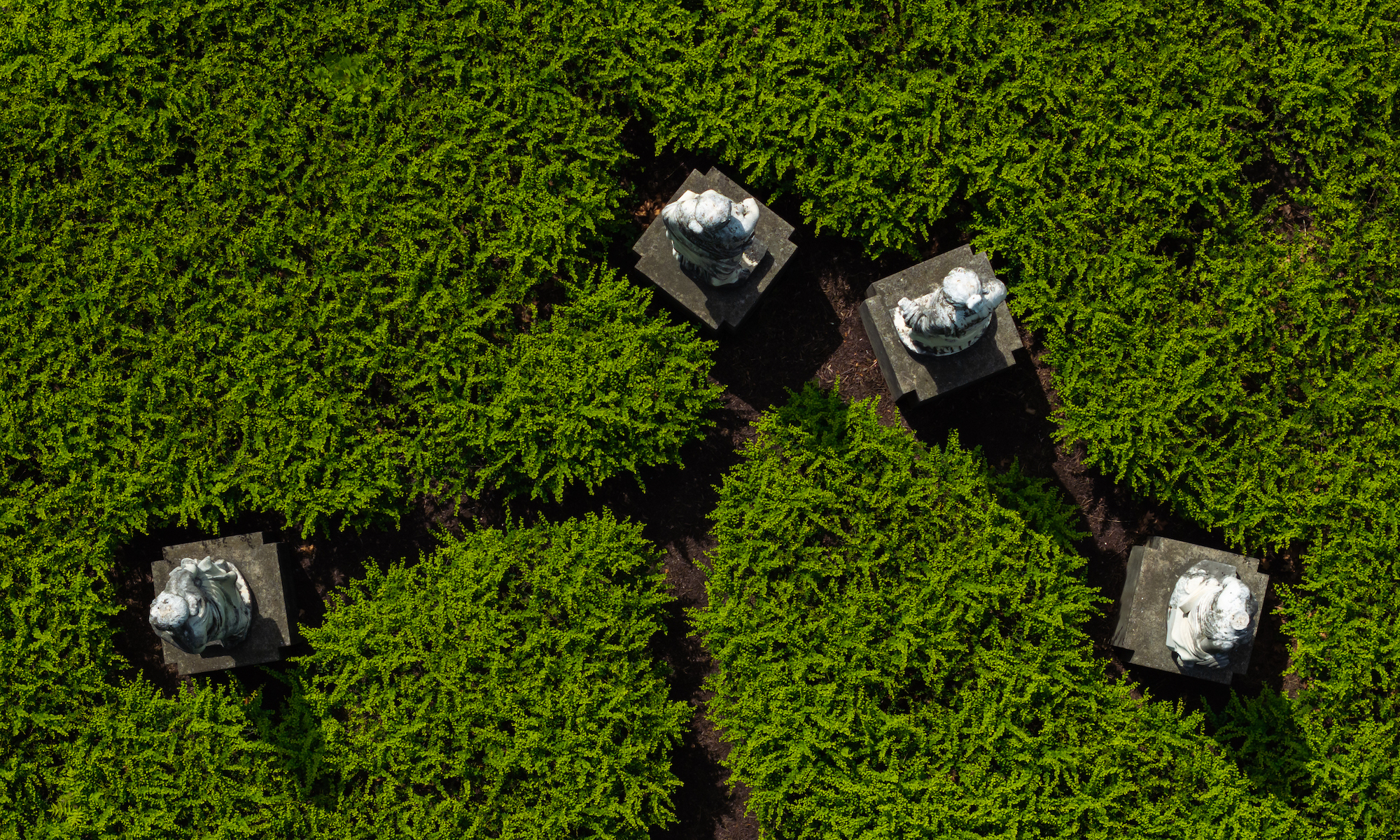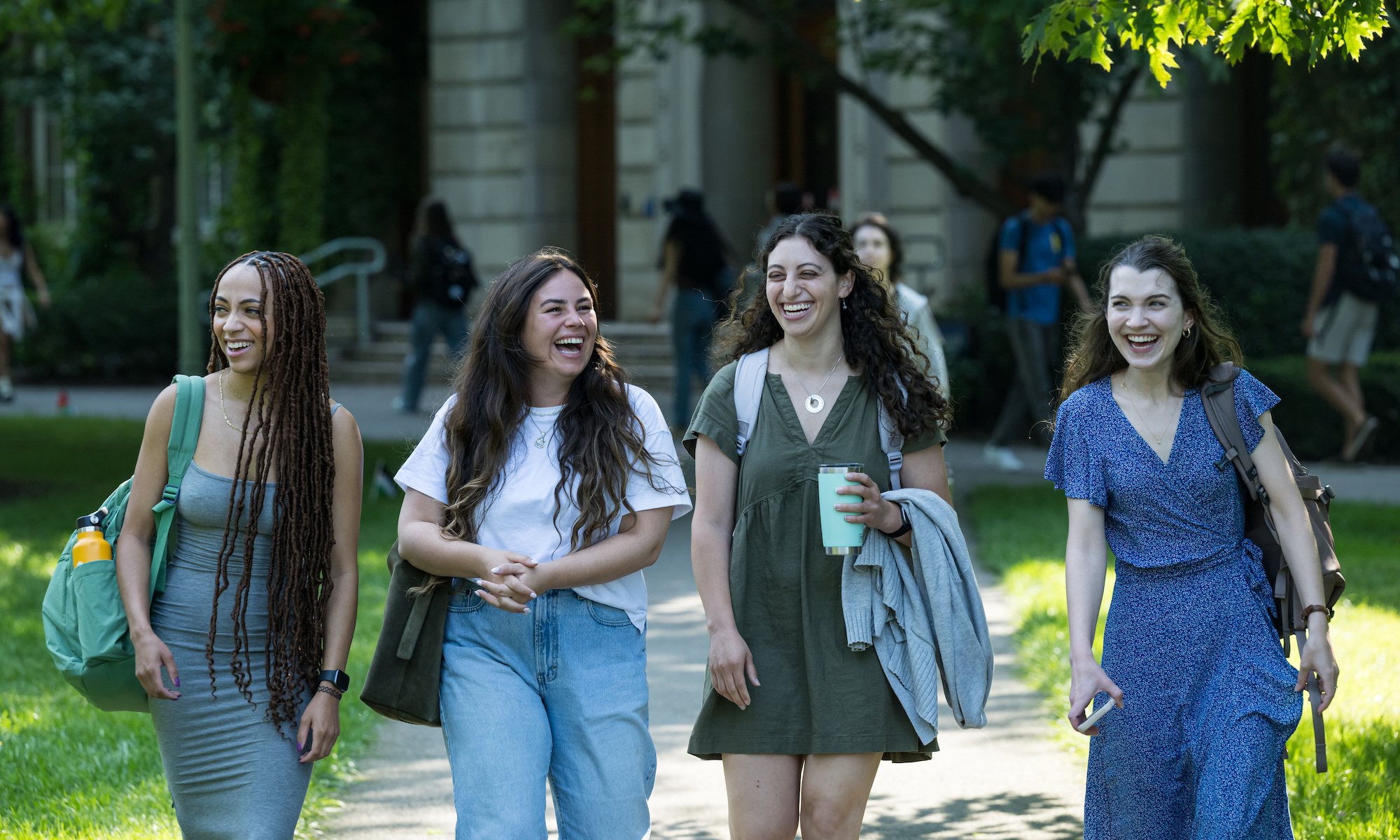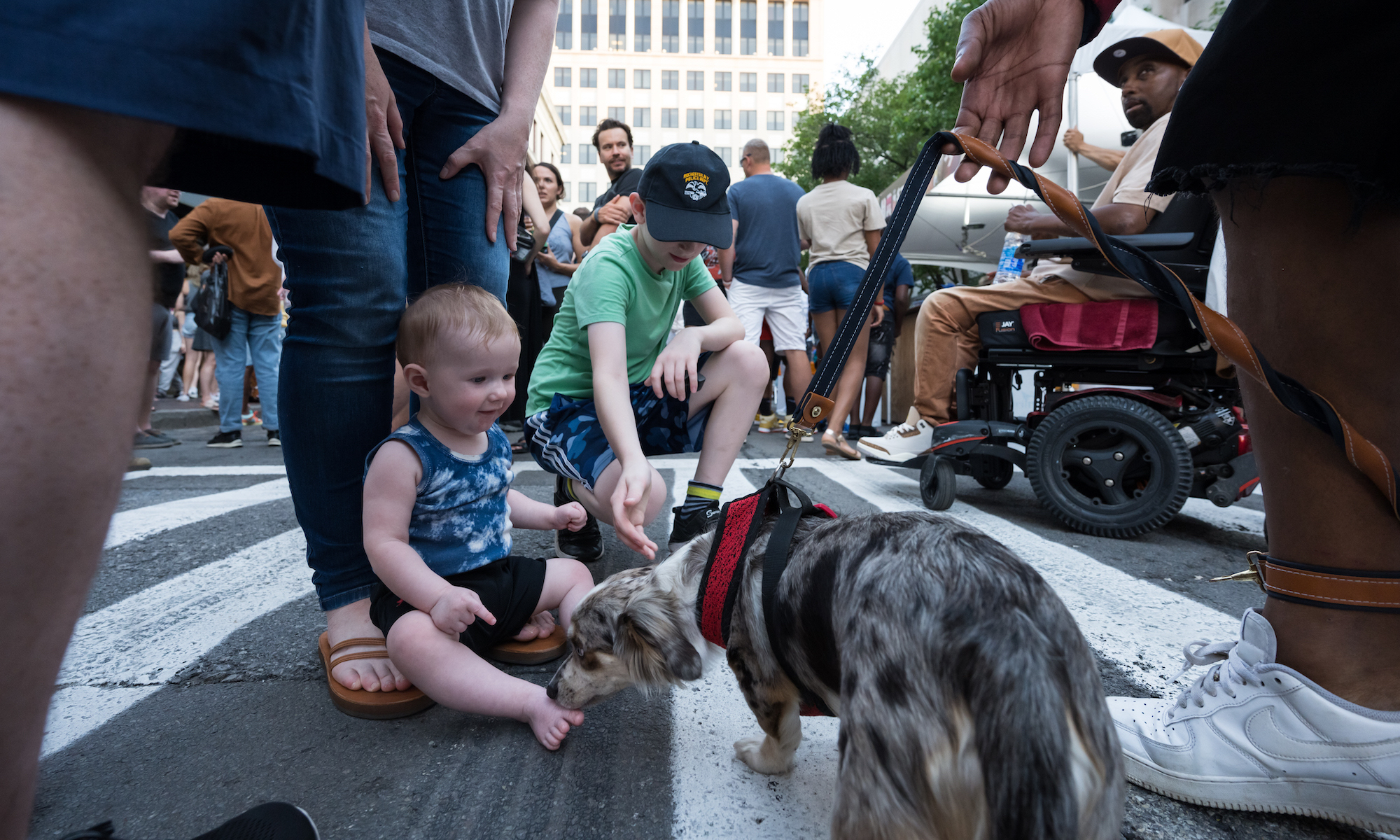University photographer J. Adam Fenster shares his favorite selections from the photos he made this year. Plus, enjoy a video recap of 2023.
From a windowless basement classroom in Meliora Hall to a twilight aerial view of the city, University photographer J. Adam Fenster has captured the scope of life at the University of Rochester throughout the year, frame by frame. As we close out 2023, we talked to Fenster about some of his favorite selections from the thousands of pictures he made this year—and some behind-the-scenes insight into what made each moment memorable.
Of course, Fenster isn’t the only communications professional with a special perspective on life at Rochester—AJ Pow, the University’s senior video producer, also documents the myriad happenings on campus and beyond. Unwind and rewind with a video montage (above) recapping a busy 2023 at Rochester.
Skaters gonna skate
Sam Becker ’25, an optics major and para ice hockey athlete, survived osteosarcoma—a form of bone cancer, which he fought for years—and which led to his decision to amputate part of his leg below the knee.
“This is probably the most compelling story. Here’s a kid who came to Rochester and is taking advantage of all the resources it has to offer. He’s just working hard,” says Fenster. “We took a lot of photos for this story, and it was hard to pick just one. This photo was taken during a practice session, where he’s skating around—and he’s got this look on his face. He’s so free and content. I appreciated this moment of joy.”

Hallway troubadours
Says Fenster: “Eastman Performing Arts Medicine (a collaboration between the Eastman School of Music and the Medical Center) reached out to me about capturing what they do. And what they do sounds cool and different—and I’ve never photographed anything like that before.”
Here, Strong Hospital music therapist Molly Pow and student physical therapist Greg Lozier work with Sharon Slottle of Vestal, New York, during a physical therapy session. Through the initiative, Eastman community members integrate performing arts into the hospital environment and provide music therapy in clinical patient care.
For Fenster, “It’s a great story—and often, the best photos begin with the best stories.”

Oh, the places you’ll go
Every March, medical students across the country find out where they’ll be placed for their residencies. Rochester is no exception.
“As someone who has photographed Match Day many times, it’s overwhelming and an abundance of potential,” shares Fenster. “A lot of these reactions are unfolding around you—it happens quickly, and it can be hard to know where to point your camera. Matt Wittmeyer, who photographed this year’s Match Day, did a great job of capturing the joy experienced by people successfully matched, and that same joy shared by their families. It’s rare to get a good, emotional photo that doesn’t feel contrived.”
Balancing act
Mary Zimmerman’s Metamorphoses, a contemporary retelling of the ancient poem by Ovid, contains abstract sexual scenes, as well as depictions of drowning, incest, and simulated violence. Setting the show as its spring production offered the International Theatre Program an opportunity to introduce an intimacy director: Sara Penner, a senior lecturer of theater in the Department of English and a voice and acting coach for the program.
“I took a lot of pictures for this on a couple of different occasions—and I took a lot of pictures of this exact moment,” remembers Fenster. “As you’re doing these things, you don’t always know what you’re looking for. But then all of a sudden it will present itself in front of you. There’s sort of a triangle formed by the actors—and then you’ve got the intimacy director in the background. If this didn’t have the intimacy director in the background, it’s just another rehearsal. I like that she’s not prominent in the photo, but she is present.
“We had to be really careful,” he adds. “These are young people, they’re not professionals, and you’re sticking a camera in their faces. It’s a privilege to be a part of it.”
This is not a drill
The annual Senior Design Day allows seniors in Hajim School departments and programs as well as students in data science and the Medical Technology and Innovation master’s degree program to showcase their senior projects. Above, “Drill Cart Charlie” driver Ryan Eamer is cheered as he takes the lead after mechanical issues.
“I love that this event exists,” says Fenster. “It’s so Rochester. The enthusiasm, the emotion. To get this photo, I’m standing up on this little wall and putting the camera up over my head. You want to get all the racers, and all the people—because that’s really the story here. And capturing the quad: that identifies it as Rochester. If I had to use one photo to illustrate this day, this would be it.”
Bottle service
Spring means Commencement. And with Commencements comes celebration. Here, Naylea Santos, a digital studies and psychology major, sprays champagne on the Eastman Quadrangle.
“Here’s a situation where you use a long lens, you isolate the subject. You set a high shutter speed, which freezes all those bubbles. The trees are turning green, finally, so you have an out-of-focus wall of color behind her. And then a little hint of the University that places it on campus.”
Scanned and camera
In the lab of Gregory Heyworth, director of the Lazarus Project and an associate professor of English, damaged manuscripts and cultural heritage objects are recovered using spectral imaging and machine learning. Here, water-damaged “safety envelopes” from the bursar’s vault of the Titanic are scanned. Recovered in 1987 from the 1912 wreck, the envelopes were once labeled clearly with the names of the passengers whose valuables they contained. Obscured after decades underwater, Heyworth and his Lazarus Project team now seek to reveal those names.
“I was inches away from something that was at the bottom of the ocean for 75-plus years,” says Fenster, somewhat awed. “I don’t know how many people do what Heyworth does. It’s pretty unique.” Noting the intensity of the visual, Fenster adds that, “the red is just one of the many different colors they use to reveal what’s hidden in these artifacts. How often do you see a big red burst captured in that way? It’s enough to make you stop and wonder what’s going on here—and that’s all you need. The purpose is to get someone to read the story. And that’s what my job is.”

Birds-eye view
For several days earlier in the year, much of Rochester was covered in a haze due to wildfires in Canada. “AJ Pow, senior video producer, sent the drone up. And I’ve photographed these hawks up on the weathervane before—but never two at a time.”
“From a technical standpoint, AJ made sure to lower the drone enough so that the weathervane sticks out against the skyline, as well as the hawks’ heads. If he was a little bit higher, all that stuff would disappear. And then the photo wouldn’t stick out. It wouldn’t draw you in.”
“Again, it tells a story—but in a quirky way,” Fenster adds, laughing. “We have these serious fires up north, we were blanketed by smoke for days—but that didn’t stop these hawks from doing whatever they do on the library.”
Ready, ‘Vette, go
“This is a great alumni story,” says Fenster of Tadge Juechter ’79, chief engineer and vehicle line director for Corvette at General Motors. Juechter is pictured above on a test track at General Motors Proving Ground in Milford, Michigan, with the four generations of Corvettes he has worked on during his 30 years with the division.
Says Fenster: “A lot of people don’t know how much time you need with a person. Or at least how much time you need on-site to get what you think is a respectable photo to illustrate the story. I was art directing cars—I’ve never done that before. To me, it’s the graphicness of the photo and the way the colors stand out.”
Fenster and Luke Auburn, senior communications officer for engineering, traveled together for this story—which rarely happens for Fenster. “Luke wrote a great piece to accompany these photos. I love being part of a team to tackle stuff like this. It captures the scope of what we do in Communications.”
How great thou art
In June of this year, the Memorial Art Gallery officially unveiled Phase II of its Centennial Sculpture Park featuring an expansive entrance on the northeast corner of University Avenue and Prince Street. Fenster took the photo via drone.
“I put the drone up to get the full scope of the park. Two or three years ago we wouldn’t have had the capability, but this illustrates the perfect situation where the drone is appropriate. You see the new part of the sculpture park and the outline of the museum. But also how it fits in with the surrounding area. It’s important if you’re trying to get a strong sense of place.”
“The art is cool, and how it’s oriented around the park is interesting. The designers clearly thought about how it would look from the air.”
Science eye-candy
“Here, we’re illustrating the Rochester iGEM (International Genetically Engineered Machine) team’s preparations for an upcoming competition,” recalls Fenster. The worldwide iGEM competition is intended to push the boundaries of synthetic biology by tackling everyday issues facing the world. Under the guidance of faculty mentor Anne S. Meyer, an associate professor of biology, the Rochester team’s project involves producing engineered, 3-D-printed yeast and bacteria that work together to efficiently replicate useful chemicals found in plants endangered by climate change.
“I would file this under ‘science eye-candy.’ Any time you have liquid nitrogen and you can add some light to it—and light it in an interesting way—it’s eye-catching. I think I had two different lights working here, and the shot was staged a couple of times to capture the most interesting photo.”
At the competition, the team received nominations for Best Biomanufacturing and Best Hardware and won a gold medal. “If this helps tell their story, and get more participants, then we’ve done our job.”
Not your parent’s computer room
“This is our newest supercomputer. And unlike the supercomputer that preceded it, this is basically a giant server rack. So it was a little harder to illustrate—but no less important.” Housed at the University’s Primary Data Center and used by the Laboratory for Laser Energetics, Conesus is on the most recent TOP500 list of the most powerful computer systems in the world and the GREEN500 list, denoting the world’s most energy-efficient supercomputers.
For Fenster, this photo benefits from the angle. “You can pick up some of the texture from the floor. It’s graphic. It’s centered. And—literally—the light at the end of the tunnel sucks you in through the rest of the frame. Similar to the Memorial Art Gallery sculpture park, some thought went into the pattern. It’s a container for what’s happening on the inside, but someone cared enough to make it look interesting on the outside. I think that’s kind of cool.”
Quantum leap year
John Nichol, an associate professor of physics, and members of his lab are exploring how dilution refrigerators can cool atoms to nearly absolute zero temperatures, making quantum computers colder and improving their performance. Above, postdoctoral associate Xinxin Cai is pictured with such a refrigerator in the Nichol lab.
“How do you illustrate quantum computing?” asks Fenster. “You find the people who do it, and you find the place where they do it, and you find the equipment they use to do it. And that’s all in this photo.”
“A lot of professors just want to do their research—which I love. But a lot of them want to feature their PhD students and postdocs. They’re just as proud of them as they are of the research. This photo illustrates that.”

Common ground
This year’s “Boundless Together: The Future of Diversity, Equity, Inclusion, and Justice” conference brought together staff, faculty, and students from across the University to engage in meaningful conversation about pressing DEIJ topics. Rapper, actor, and activist Common, pictured above with Norma Holland, director of public relations and engagement for the Office of Equity and Inclusion at the School of Medicine and Dentistry, was the keynote speaker.
“We get famous people coming to the University and giving inspiring speeches from time to time. But it can be difficult to show them in a distinctly Rochester place. How do you get a photo that ties it all to Rochester? Well, you get a really popular and beloved Rochester ambassador in Norma together with Common, the speaker. It’s a joyful moment. It looks like they’re old friends.”
Teachable moments
One of three recipients of this year’s Goergen Awards for Excellence in Undergraduate Teaching in Arts, Sciences & Engineering, Jack Downey, the John Henry Newman Chair in Roman Catholic Studies in the Department of Religion and Classics, is shown leading his civil disobedience class in Meliora Hall.
“For these awards, you can use an old headshot, you can use a photo from the ceremony, or you can photograph the recipient doing what they did to win the award. And that’s teach,” says Fenster. “He was really engaging, and I could see why he would receive this award.”
“This photo is a moment. I can’t remember what was being said, but the photo tells the story of both Downey and his students. It’s a drab, windowless classroom—but there’s still this magic happening.”

Beetle-mania
“When I found out there was actual research that goes on in Mt. Hope Cemetery—that’s pretty interesting,” notes Fenster of the study of blister beetle populations in a class taught by Robert Minckley, a professor of instruction in the Department of Biology. “It demonstrates the ability of students and faculty to get out of the classroom. They’re going right next door. You can do your science in a lab, but also right beside the University. It feels uniquely Rochester.”
“If I’m available, I’ll go out and photograph this every year. And of course, I’ll capture the beetles. But sometimes you step back and get the whole context. You have the compressed scene of the two students (Hanna Chin ’24 (L) and Allison Tilburg ’25) in the foreground. And then behind them are all these tombstones. It’s kind of bizarre! What are they doing out there? Any time you can create a photo that prompts people to ask questions, that’s a good thing.”

Night moves
“This is me in a helicopter for the first time in my life,” shares Fenster of this aerial photo captured in October. “Fall is always a good time to capture this sort of perspective. You have the leaves changing color, the air gets a little more still and clear, and the light does what you want it to do. It comes from the right angles. Weather, time of day, time of year: those are all factors that come into play for an aerial shoot.”
“It was a nice, warm day. I was all strapped in but my cameras weren’t. So if we’d banked, they would have rolled out. I wanted to stay up in the air for a couple of hours to get the sunset, what we call the ‘blue hour,’ and the twilight hour—which is when this photo was taken. It’s where the sun is already set, but the lights are starting to twinkle. I took thousands of images during that shoot. I’m still editing them.”
Shining a light on the past
“This photo is different because I read about it in @Rochester,” shares Fenster. In November, Rossell Hope Robbins Library invited visitors to view pages of hand-written manuscripts spanning the Middle Ages from its collection by electric candlelight in the Great Hall. “Any time you have flames—even if they’re fake—in the dark, with old manuscripts, it just sounds cool, right?”
“It’s visually interesting, but it’s also great that the library is opening up and putting out its collections for the University community to see—and to not showcase these pieces traditionally under bright lights. You can see details, but only certain details due to the candlelight. It was magical, however contrived.”
It takes two
In November, University President and the G. Robert Witmer Jr. University Professor Sarah Mangelsdorf—an accomplished scholar of child development—gave a guest lecture in the child development class led by her husband, Karl Rosengren, a professor of brain and cognitive sciences and of psychology.
“This was a charming moment between the president and her husband as she was giving a guest lecture in his class. I’ve never been in a situation quite like that. At the very end, they went out in front of the class together. And I think the president was talking about some sort of scenario, and her husband was pretending to be offended. So I ripped off a couple of frames, and this is that. Graphically, the composition also works, but mostly it’s about the moment and the obvious love they have for each other. But it stands out because they’re in a classroom.”



